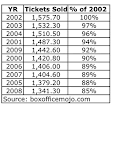As a result of DANTH’s 2008-2013 downtown trend assessment work, we became very concerned about the future of movie theaters in a lot of medium-sized downtowns,so we keep our eyes out for news about the movie industry. In my February 24, 2008 posting, “DOWNTOWN MOVIE THEATERS WILL BE INCREASINGLY IN PERIL” I noted that according to a PEW survey:“By a five-to-one ratio Americans view films more at home than they do in movie theaters. Move theaters account for only about 12% of the movie industry’s revenues”
And, according to that same PEW survey, this trend toward watching movies at home was growing. The implicit danger posed by this trend for downtown cinemas, that often are just scrapping by, is a relentless deterioration in attendance and revenues.
Some Recent Observations in the NY Times
A recent article in the May 29, 2011 edition of New York Times had a title that grabbed my attention: “3-D Starts to Fizzle, and Hollywood Frets,” The reporters, Brooks Barnes and Michael Cieply, state that: “The box-office performance in the first six months of 2011 was soft — revenue fell about 9 percent compared with last year, while attendance was down 10 percent.” That’s off of a 5.25% attendance decine reported by boxoffice.com for 2010. To give those delines some perspective, remember that a mere six percent drop in attendance back in 2000-2001 pushed most of the theater chains into bankruptcy. The current drop in attendance and revenues might be explained by our stalled economy and/or rocketing gasoline prices, neither of which promise to soon disappear.
Many Hollywood big wigs, such as James Cameron and Jeffrey Katzenberg, have argued that 3-D movies would save the industry by bolstering audiences and revenues. But Barnes and Cieply also report that now “there is strong consumer resistance to high 3-D ticket prices” and “the novelty of putting on the funny glasses is wearing off.” While the best 3-D feature films still are doing well at the box office, 3-D films of more ho-hum quality are taking a box office beating in the USA.
Barnes and Cieply also reported that rentals in video stores during the first part of the year fell 36 percent. This fact would be consistent with the crumbling of the Blockbuster chain and a substantial growth in the streaming and downloading of films to home TV and computer screens through Internet services such as Netflix, Amazon and iTunes. The latter was a possibility DANTH’s trends assessment feared would be all too likely.
My Take-Aways
With retail gasping for breath in most downtown and Main Streets commercial areas, their entertainment niches have taken on an even greater importance than they have had in the past. Downtown movie theaters are often the cornerstones of these niches and the recent decline in attendance suggests they may be facing substantially increased financial stress.
Strengthening downtown entertainment niches in small and medium-sized communities will probably follow two strategic paths:
- Buttressing the magnetism of the movie theaters through a package of improvements that includes: 3-D and IMAX screening capabilities; tie-ins with adjacent or in-house restaurants, bars, brew-pubs, ice cream parlors, etc.; clean theaters, with comfortable seating and audiences displaying civil behavior
- Developing non-formal entertainments, most importantly in well-activated public spaces and restaurants.
What’s Happening in Your Downtown?
Please let me know what is happening in your downtown or Main Street district. If thereare sufficient responses, I will report on them in special posting to this blog.
N. David Milder
